Western Sydney University: Youth and Crime Case Study Analysis
VerifiedAdded on 2022/10/19
|9
|1462
|447
Report
AI Summary
This report provides an in-depth analysis of the case involving a youth named CW, focusing on the nature and consequences of the crime. It examines the incident where an eleven-year-old was found guilty of misbehaviour with the Australian Police and served a finite term of imprisonment. The report explores the age-crime curve, the influence of exosystems, mesosystems, and microsystems as described by Bronfenbrenner's ecological systems theory. It highlights the police's handling of the situation, the importance of communication, and the need for rehabilitation programs. The analysis also considers the impact of social factors like homelessness, substance abuse, and the application of legal frameworks. The report concludes with a call for improved nurturing, education, and collaboration between juvenile justice systems, NGOs, and childcare organizations to support and empower young offenders.
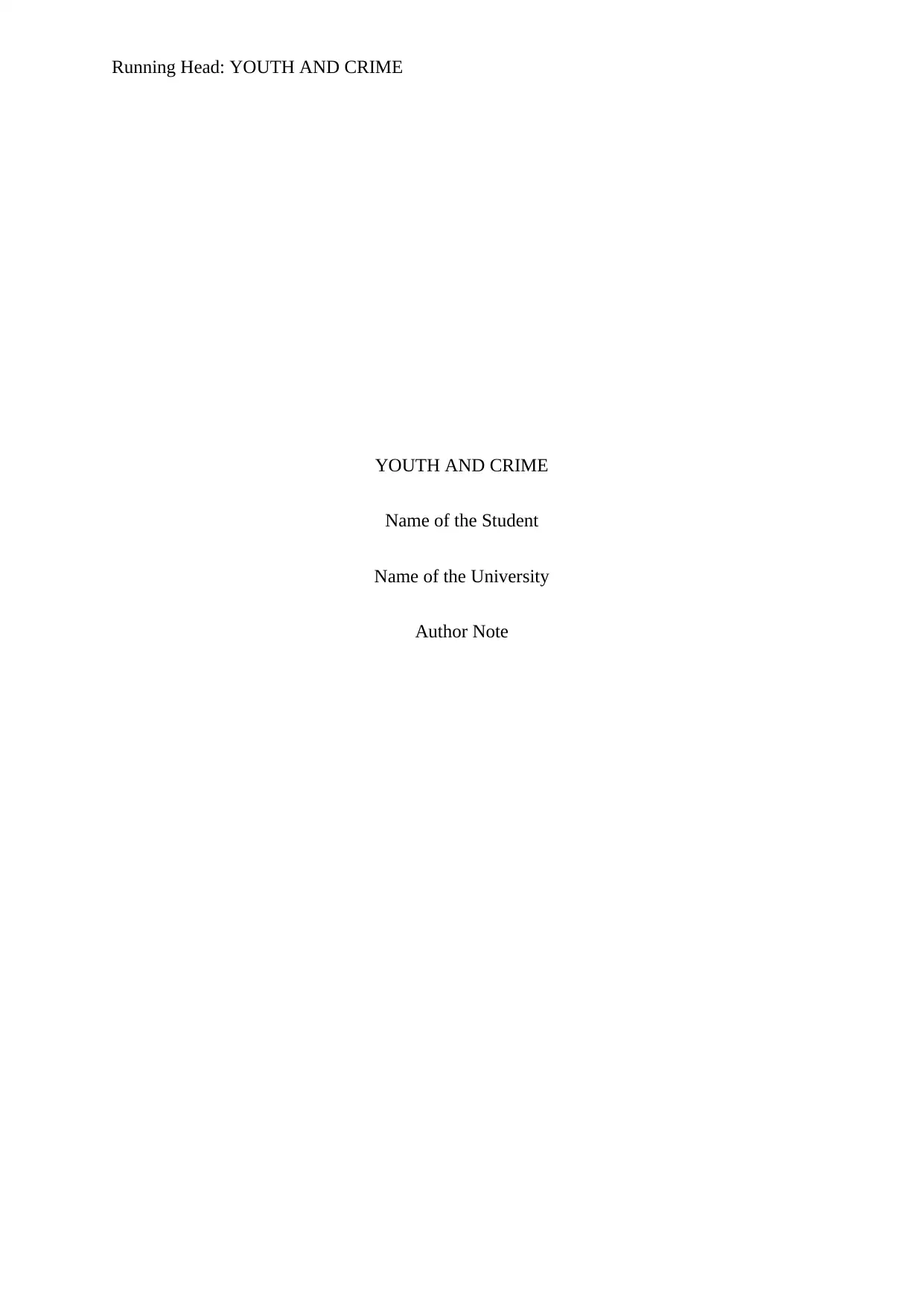
Running Head: YOUTH AND CRIME
YOUTH AND CRIME
Name of the Student
Name of the University
Author Note
YOUTH AND CRIME
Name of the Student
Name of the University
Author Note
Paraphrase This Document
Need a fresh take? Get an instant paraphrase of this document with our AI Paraphraser
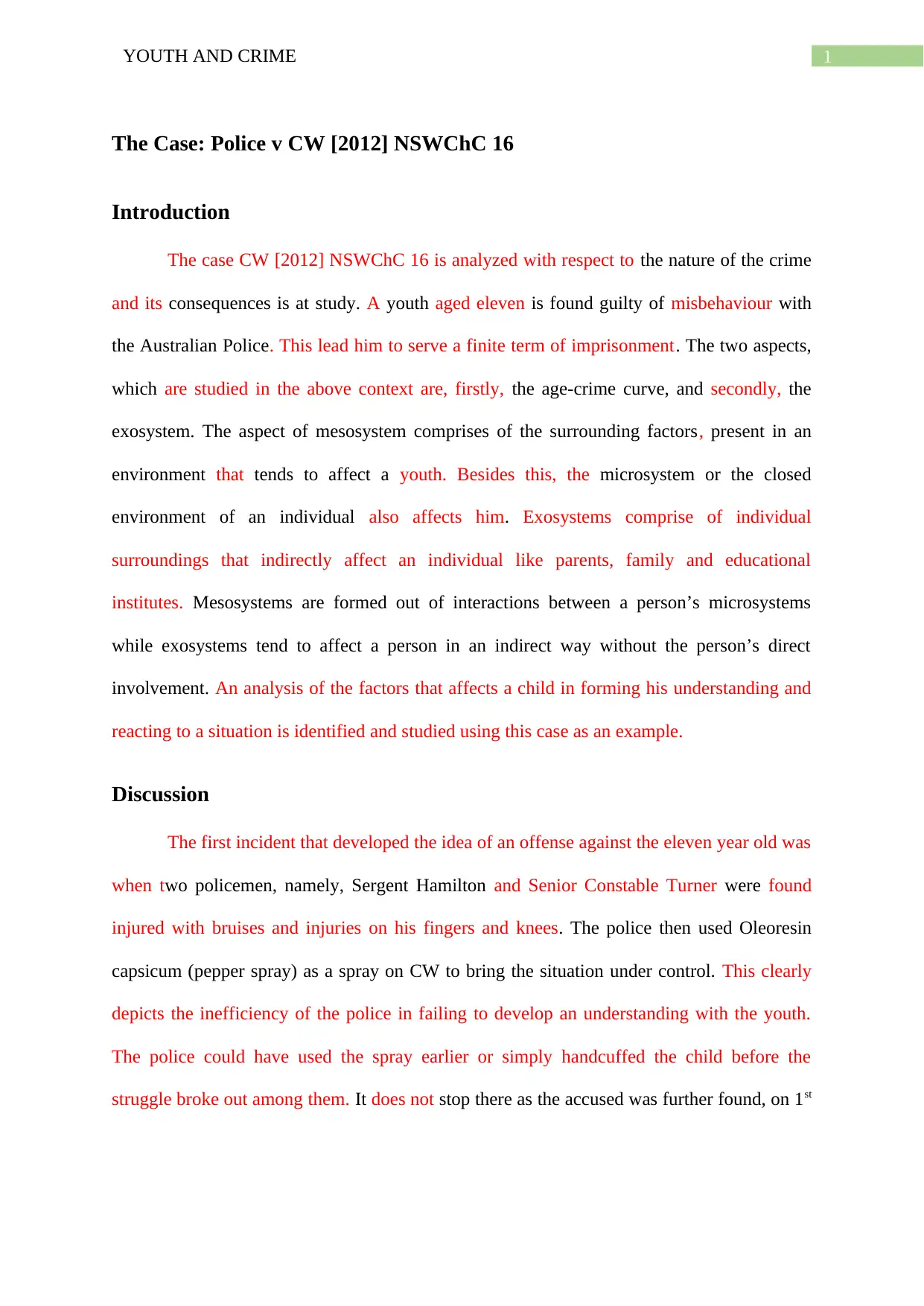
1YOUTH AND CRIME
The Case: Police v CW [2012] NSWChC 16
Introduction
The case CW [2012] NSWChC 16 is analyzed with respect to the nature of the crime
and its consequences is at study. A youth aged eleven is found guilty of misbehaviour with
the Australian Police. This lead him to serve a finite term of imprisonment. The two aspects,
which are studied in the above context are, firstly, the age-crime curve, and secondly, the
exosystem. The aspect of mesosystem comprises of the surrounding factors, present in an
environment that tends to affect a youth. Besides this, the microsystem or the closed
environment of an individual also affects him. Exosystems comprise of individual
surroundings that indirectly affect an individual like parents, family and educational
institutes. Mesosystems are formed out of interactions between a person’s microsystems
while exosystems tend to affect a person in an indirect way without the person’s direct
involvement. An analysis of the factors that affects a child in forming his understanding and
reacting to a situation is identified and studied using this case as an example.
Discussion
The first incident that developed the idea of an offense against the eleven year old was
when two policemen, namely, Sergent Hamilton and Senior Constable Turner were found
injured with bruises and injuries on his fingers and knees. The police then used Oleoresin
capsicum (pepper spray) as a spray on CW to bring the situation under control. This clearly
depicts the inefficiency of the police in failing to develop an understanding with the youth.
The police could have used the spray earlier or simply handcuffed the child before the
struggle broke out among them. It does not stop there as the accused was further found, on 1st
The Case: Police v CW [2012] NSWChC 16
Introduction
The case CW [2012] NSWChC 16 is analyzed with respect to the nature of the crime
and its consequences is at study. A youth aged eleven is found guilty of misbehaviour with
the Australian Police. This lead him to serve a finite term of imprisonment. The two aspects,
which are studied in the above context are, firstly, the age-crime curve, and secondly, the
exosystem. The aspect of mesosystem comprises of the surrounding factors, present in an
environment that tends to affect a youth. Besides this, the microsystem or the closed
environment of an individual also affects him. Exosystems comprise of individual
surroundings that indirectly affect an individual like parents, family and educational
institutes. Mesosystems are formed out of interactions between a person’s microsystems
while exosystems tend to affect a person in an indirect way without the person’s direct
involvement. An analysis of the factors that affects a child in forming his understanding and
reacting to a situation is identified and studied using this case as an example.
Discussion
The first incident that developed the idea of an offense against the eleven year old was
when two policemen, namely, Sergent Hamilton and Senior Constable Turner were found
injured with bruises and injuries on his fingers and knees. The police then used Oleoresin
capsicum (pepper spray) as a spray on CW to bring the situation under control. This clearly
depicts the inefficiency of the police in failing to develop an understanding with the youth.
The police could have used the spray earlier or simply handcuffed the child before the
struggle broke out among them. It does not stop there as the accused was further found, on 1st
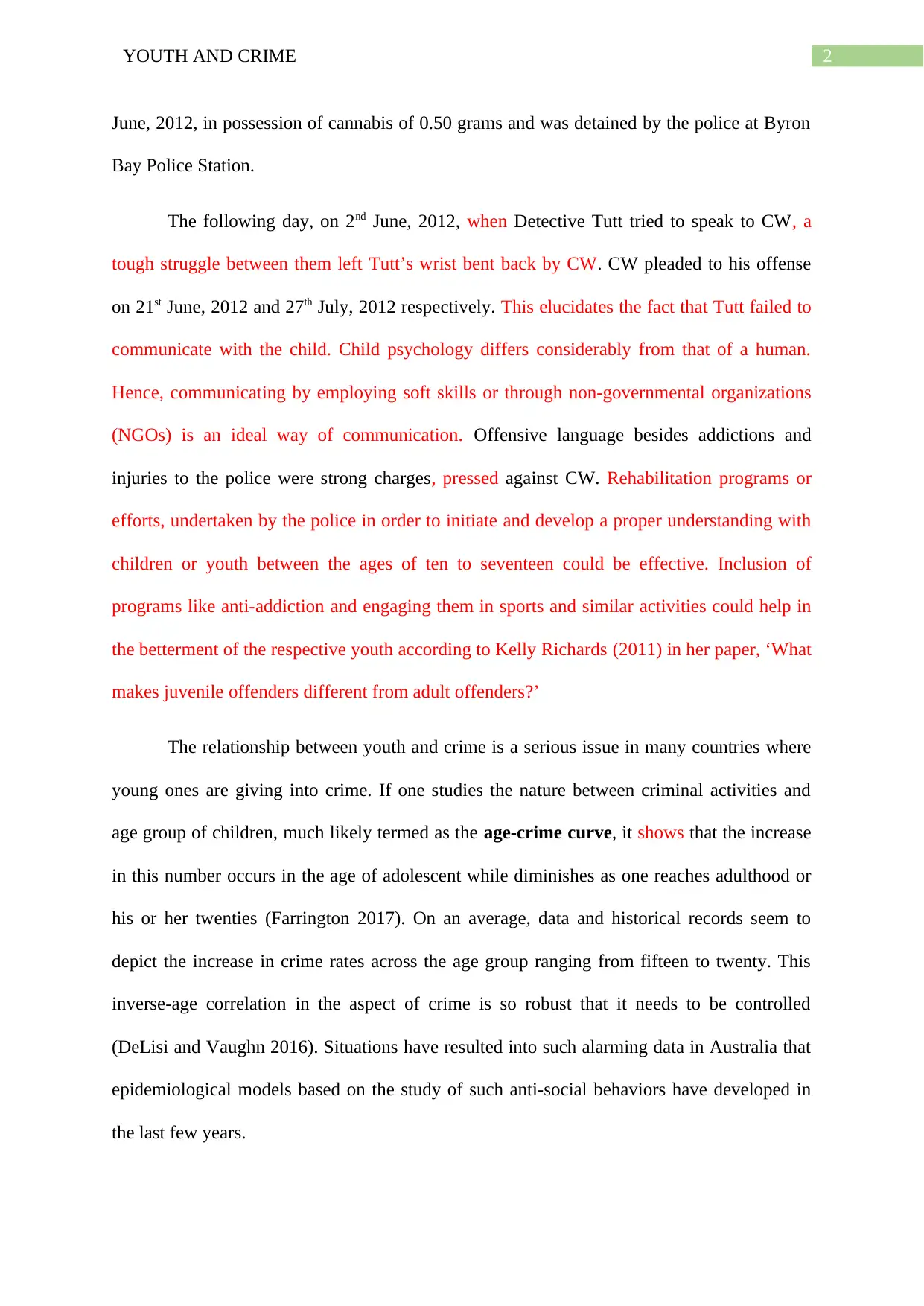
2YOUTH AND CRIME
June, 2012, in possession of cannabis of 0.50 grams and was detained by the police at Byron
Bay Police Station.
The following day, on 2nd June, 2012, when Detective Tutt tried to speak to CW, a
tough struggle between them left Tutt’s wrist bent back by CW. CW pleaded to his offense
on 21st June, 2012 and 27th July, 2012 respectively. This elucidates the fact that Tutt failed to
communicate with the child. Child psychology differs considerably from that of a human.
Hence, communicating by employing soft skills or through non-governmental organizations
(NGOs) is an ideal way of communication. Offensive language besides addictions and
injuries to the police were strong charges, pressed against CW. Rehabilitation programs or
efforts, undertaken by the police in order to initiate and develop a proper understanding with
children or youth between the ages of ten to seventeen could be effective. Inclusion of
programs like anti-addiction and engaging them in sports and similar activities could help in
the betterment of the respective youth according to Kelly Richards (2011) in her paper, ‘What
makes juvenile offenders different from adult offenders?’
The relationship between youth and crime is a serious issue in many countries where
young ones are giving into crime. If one studies the nature between criminal activities and
age group of children, much likely termed as the age-crime curve, it shows that the increase
in this number occurs in the age of adolescent while diminishes as one reaches adulthood or
his or her twenties (Farrington 2017). On an average, data and historical records seem to
depict the increase in crime rates across the age group ranging from fifteen to twenty. This
inverse-age correlation in the aspect of crime is so robust that it needs to be controlled
(DeLisi and Vaughn 2016). Situations have resulted into such alarming data in Australia that
epidemiological models based on the study of such anti-social behaviors have developed in
the last few years.
June, 2012, in possession of cannabis of 0.50 grams and was detained by the police at Byron
Bay Police Station.
The following day, on 2nd June, 2012, when Detective Tutt tried to speak to CW, a
tough struggle between them left Tutt’s wrist bent back by CW. CW pleaded to his offense
on 21st June, 2012 and 27th July, 2012 respectively. This elucidates the fact that Tutt failed to
communicate with the child. Child psychology differs considerably from that of a human.
Hence, communicating by employing soft skills or through non-governmental organizations
(NGOs) is an ideal way of communication. Offensive language besides addictions and
injuries to the police were strong charges, pressed against CW. Rehabilitation programs or
efforts, undertaken by the police in order to initiate and develop a proper understanding with
children or youth between the ages of ten to seventeen could be effective. Inclusion of
programs like anti-addiction and engaging them in sports and similar activities could help in
the betterment of the respective youth according to Kelly Richards (2011) in her paper, ‘What
makes juvenile offenders different from adult offenders?’
The relationship between youth and crime is a serious issue in many countries where
young ones are giving into crime. If one studies the nature between criminal activities and
age group of children, much likely termed as the age-crime curve, it shows that the increase
in this number occurs in the age of adolescent while diminishes as one reaches adulthood or
his or her twenties (Farrington 2017). On an average, data and historical records seem to
depict the increase in crime rates across the age group ranging from fifteen to twenty. This
inverse-age correlation in the aspect of crime is so robust that it needs to be controlled
(DeLisi and Vaughn 2016). Situations have resulted into such alarming data in Australia that
epidemiological models based on the study of such anti-social behaviors have developed in
the last few years.
⊘ This is a preview!⊘
Do you want full access?
Subscribe today to unlock all pages.

Trusted by 1+ million students worldwide
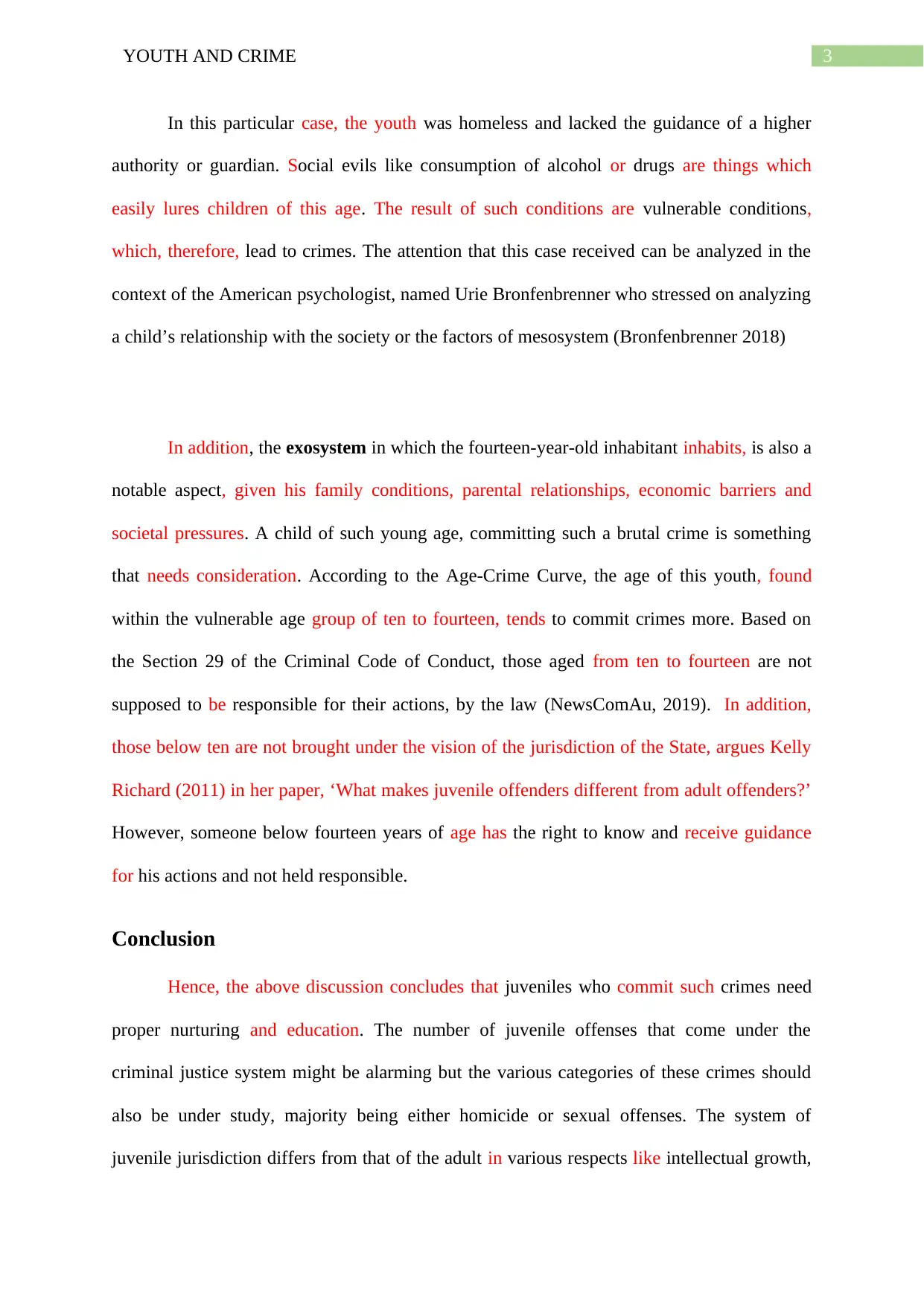
3YOUTH AND CRIME
In this particular case, the youth was homeless and lacked the guidance of a higher
authority or guardian. Social evils like consumption of alcohol or drugs are things which
easily lures children of this age. The result of such conditions are vulnerable conditions,
which, therefore, lead to crimes. The attention that this case received can be analyzed in the
context of the American psychologist, named Urie Bronfenbrenner who stressed on analyzing
a child’s relationship with the society or the factors of mesosystem (Bronfenbrenner 2018)
In addition, the exosystem in which the fourteen-year-old inhabitant inhabits, is also a
notable aspect, given his family conditions, parental relationships, economic barriers and
societal pressures. A child of such young age, committing such a brutal crime is something
that needs consideration. According to the Age-Crime Curve, the age of this youth, found
within the vulnerable age group of ten to fourteen, tends to commit crimes more. Based on
the Section 29 of the Criminal Code of Conduct, those aged from ten to fourteen are not
supposed to be responsible for their actions, by the law (NewsComAu, 2019). In addition,
those below ten are not brought under the vision of the jurisdiction of the State, argues Kelly
Richard (2011) in her paper, ‘What makes juvenile offenders different from adult offenders?’
However, someone below fourteen years of age has the right to know and receive guidance
for his actions and not held responsible.
Conclusion
Hence, the above discussion concludes that juveniles who commit such crimes need
proper nurturing and education. The number of juvenile offenses that come under the
criminal justice system might be alarming but the various categories of these crimes should
also be under study, majority being either homicide or sexual offenses. The system of
juvenile jurisdiction differs from that of the adult in various respects like intellectual growth,
In this particular case, the youth was homeless and lacked the guidance of a higher
authority or guardian. Social evils like consumption of alcohol or drugs are things which
easily lures children of this age. The result of such conditions are vulnerable conditions,
which, therefore, lead to crimes. The attention that this case received can be analyzed in the
context of the American psychologist, named Urie Bronfenbrenner who stressed on analyzing
a child’s relationship with the society or the factors of mesosystem (Bronfenbrenner 2018)
In addition, the exosystem in which the fourteen-year-old inhabitant inhabits, is also a
notable aspect, given his family conditions, parental relationships, economic barriers and
societal pressures. A child of such young age, committing such a brutal crime is something
that needs consideration. According to the Age-Crime Curve, the age of this youth, found
within the vulnerable age group of ten to fourteen, tends to commit crimes more. Based on
the Section 29 of the Criminal Code of Conduct, those aged from ten to fourteen are not
supposed to be responsible for their actions, by the law (NewsComAu, 2019). In addition,
those below ten are not brought under the vision of the jurisdiction of the State, argues Kelly
Richard (2011) in her paper, ‘What makes juvenile offenders different from adult offenders?’
However, someone below fourteen years of age has the right to know and receive guidance
for his actions and not held responsible.
Conclusion
Hence, the above discussion concludes that juveniles who commit such crimes need
proper nurturing and education. The number of juvenile offenses that come under the
criminal justice system might be alarming but the various categories of these crimes should
also be under study, majority being either homicide or sexual offenses. The system of
juvenile jurisdiction differs from that of the adult in various respects like intellectual growth,
Paraphrase This Document
Need a fresh take? Get an instant paraphrase of this document with our AI Paraphraser

4YOUTH AND CRIME
mental illness, exosystems in which the youth inhabits and other socio-political and
economical barriers. Thus, building a system of fair trial with the help of NGOs,
rehabilitation centers and child-care organizations like UNICEF should collaborate with the
police in developing measures to minutely asses, educate and empower these youth, for fair
and speedy trials.
mental illness, exosystems in which the youth inhabits and other socio-political and
economical barriers. Thus, building a system of fair trial with the help of NGOs,
rehabilitation centers and child-care organizations like UNICEF should collaborate with the
police in developing measures to minutely asses, educate and empower these youth, for fair
and speedy trials.

5YOUTH AND CRIME
⊘ This is a preview!⊘
Do you want full access?
Subscribe today to unlock all pages.

Trusted by 1+ million students worldwide
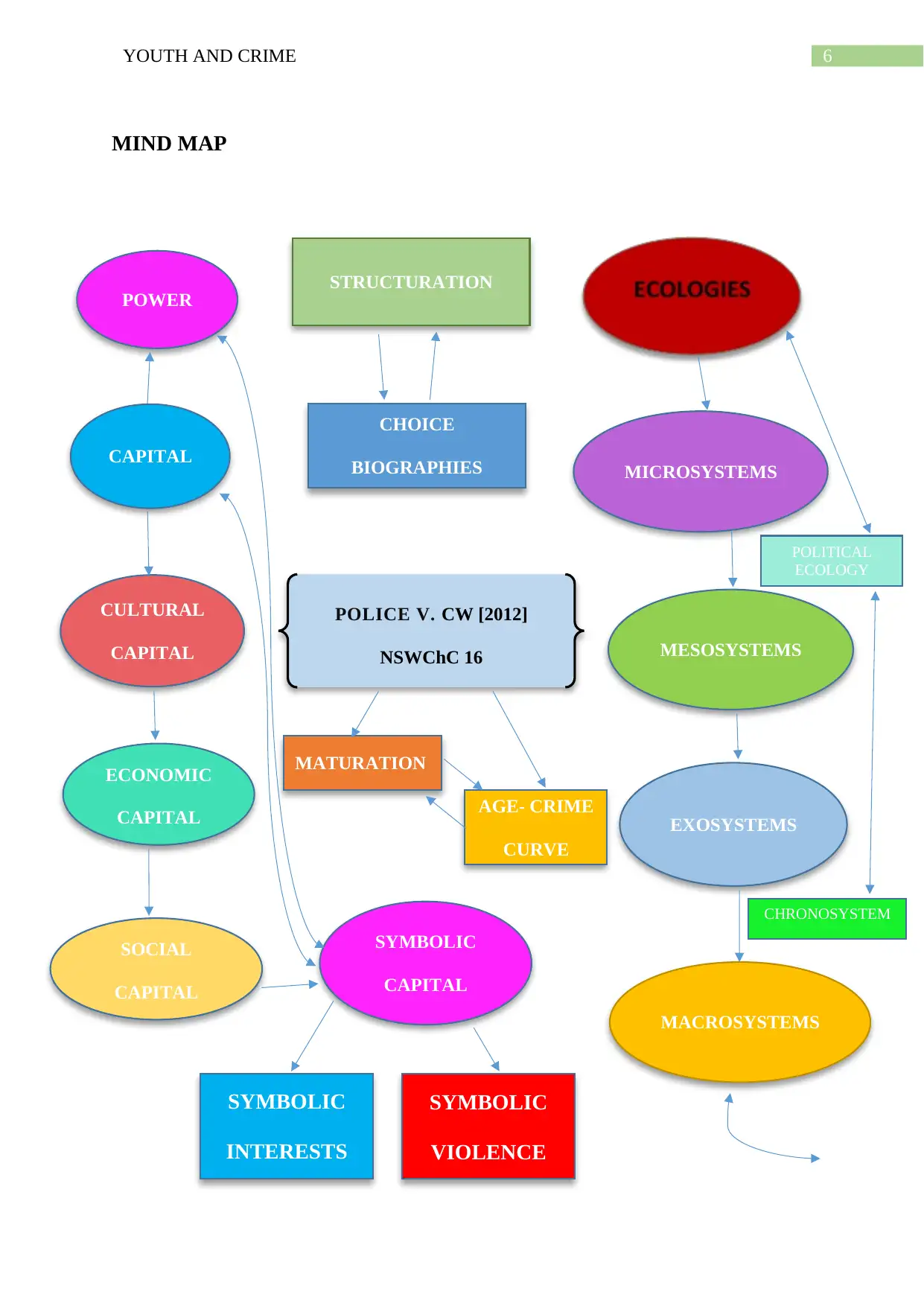
6YOUTH AND CRIME
MIND MAP
POWER
CAPITAL
CULTURAL
CAPITAL
MICROSYSTEMS
MESOSYSTEMS
EXOSYSTEMS
MACROSYSTEMS
ECONOMIC
CAPITAL
SOCIAL
CAPITAL
SYMBOLIC
INTERESTS
SYMBOLIC
VIOLENCE
STRUCTURATION
SYMBOLIC
CAPITAL
CHOICE
BIOGRAPHIES
POLICE V. CW [2012]
NSWChC 16
MATURATION
AGE- CRIME
CURVE
POLITICAL
ECOLOGY
CHRONOSYSTEM
M
MIND MAP
POWER
CAPITAL
CULTURAL
CAPITAL
MICROSYSTEMS
MESOSYSTEMS
EXOSYSTEMS
MACROSYSTEMS
ECONOMIC
CAPITAL
SOCIAL
CAPITAL
SYMBOLIC
INTERESTS
SYMBOLIC
VIOLENCE
STRUCTURATION
SYMBOLIC
CAPITAL
CHOICE
BIOGRAPHIES
POLICE V. CW [2012]
NSWChC 16
MATURATION
AGE- CRIME
CURVE
POLITICAL
ECOLOGY
CHRONOSYSTEM
M
Paraphrase This Document
Need a fresh take? Get an instant paraphrase of this document with our AI Paraphraser
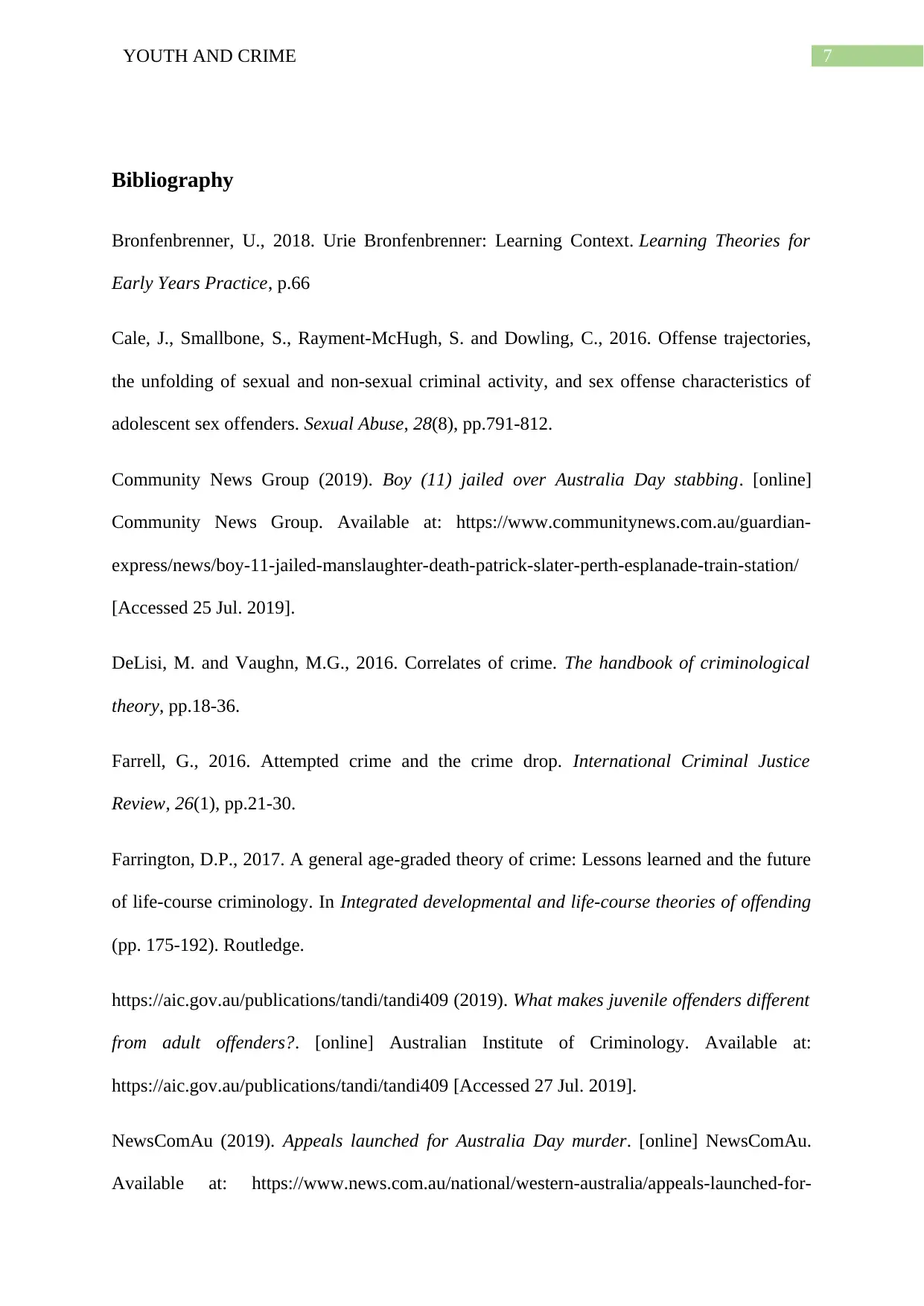
7YOUTH AND CRIME
Bibliography
Bronfenbrenner, U., 2018. Urie Bronfenbrenner: Learning Context. Learning Theories for
Early Years Practice, p.66
Cale, J., Smallbone, S., Rayment-McHugh, S. and Dowling, C., 2016. Offense trajectories,
the unfolding of sexual and non-sexual criminal activity, and sex offense characteristics of
adolescent sex offenders. Sexual Abuse, 28(8), pp.791-812.
Community News Group (2019). Boy (11) jailed over Australia Day stabbing. [online]
Community News Group. Available at: https://www.communitynews.com.au/guardian-
express/news/boy-11-jailed-manslaughter-death-patrick-slater-perth-esplanade-train-station/
[Accessed 25 Jul. 2019].
DeLisi, M. and Vaughn, M.G., 2016. Correlates of crime. The handbook of criminological
theory, pp.18-36.
Farrell, G., 2016. Attempted crime and the crime drop. International Criminal Justice
Review, 26(1), pp.21-30.
Farrington, D.P., 2017. A general age-graded theory of crime: Lessons learned and the future
of life-course criminology. In Integrated developmental and life-course theories of offending
(pp. 175-192). Routledge.
https://aic.gov.au/publications/tandi/tandi409 (2019). What makes juvenile offenders different
from adult offenders?. [online] Australian Institute of Criminology. Available at:
https://aic.gov.au/publications/tandi/tandi409 [Accessed 27 Jul. 2019].
NewsComAu (2019). Appeals launched for Australia Day murder. [online] NewsComAu.
Available at: https://www.news.com.au/national/western-australia/appeals-launched-for-
Bibliography
Bronfenbrenner, U., 2018. Urie Bronfenbrenner: Learning Context. Learning Theories for
Early Years Practice, p.66
Cale, J., Smallbone, S., Rayment-McHugh, S. and Dowling, C., 2016. Offense trajectories,
the unfolding of sexual and non-sexual criminal activity, and sex offense characteristics of
adolescent sex offenders. Sexual Abuse, 28(8), pp.791-812.
Community News Group (2019). Boy (11) jailed over Australia Day stabbing. [online]
Community News Group. Available at: https://www.communitynews.com.au/guardian-
express/news/boy-11-jailed-manslaughter-death-patrick-slater-perth-esplanade-train-station/
[Accessed 25 Jul. 2019].
DeLisi, M. and Vaughn, M.G., 2016. Correlates of crime. The handbook of criminological
theory, pp.18-36.
Farrell, G., 2016. Attempted crime and the crime drop. International Criminal Justice
Review, 26(1), pp.21-30.
Farrington, D.P., 2017. A general age-graded theory of crime: Lessons learned and the future
of life-course criminology. In Integrated developmental and life-course theories of offending
(pp. 175-192). Routledge.
https://aic.gov.au/publications/tandi/tandi409 (2019). What makes juvenile offenders different
from adult offenders?. [online] Australian Institute of Criminology. Available at:
https://aic.gov.au/publications/tandi/tandi409 [Accessed 27 Jul. 2019].
NewsComAu (2019). Appeals launched for Australia Day murder. [online] NewsComAu.
Available at: https://www.news.com.au/national/western-australia/appeals-launched-for-

8YOUTH AND CRIME
australia-day-murder/news-story/680de16778bb8c663328778fd976d339 [Accessed 25 Jul.
2019].
australia-day-murder/news-story/680de16778bb8c663328778fd976d339 [Accessed 25 Jul.
2019].
⊘ This is a preview!⊘
Do you want full access?
Subscribe today to unlock all pages.

Trusted by 1+ million students worldwide
1 out of 9
Your All-in-One AI-Powered Toolkit for Academic Success.
+13062052269
info@desklib.com
Available 24*7 on WhatsApp / Email
![[object Object]](/_next/static/media/star-bottom.7253800d.svg)
Unlock your academic potential
Copyright © 2020–2025 A2Z Services. All Rights Reserved. Developed and managed by ZUCOL.